Few places in Poland can rival Malbork when it comes to sheer medieval grandeur. You’ve likely stumbled upon this travel guide because you’re curious about the things to do in a town famed for hosting one of the world’s largest brick castles. Nestled along the tranquil Nogat River, Malbork offers more than just an awe-inspiring fortress. It brims with local flair, scenic river walks, and robust Polish cuisine.
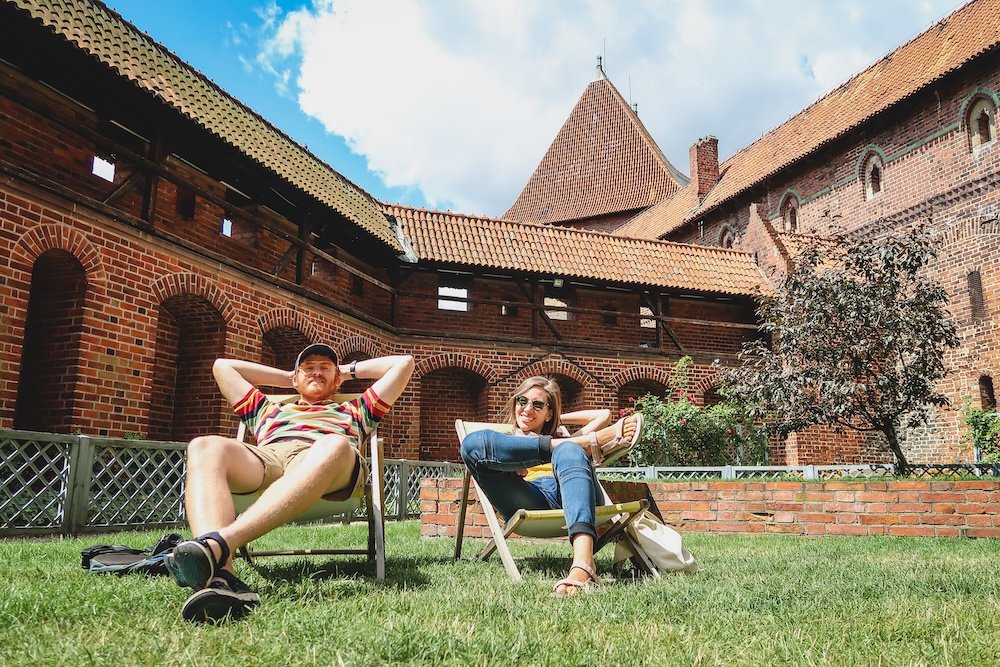
You’re here to discover what Malbork brings to the table: maybe you heard about the Teutonic Knights’ imposing stronghold, or you’re planning a day trip from Gdańsk. How do you spend your time effectively? Which corners of the castle hold hidden gems? And what about food, transport, or day trips? Relax—you’ll find all that laid out here.
Planning a visit to a smaller Polish town can spark worries: is the castle enough to fill a day or more? How do you handle train schedules or manage high-season crowds? Can non-history buffs still enjoy Malbork? We’ll tackle these concerns. No guesswork—just clear, usable info.
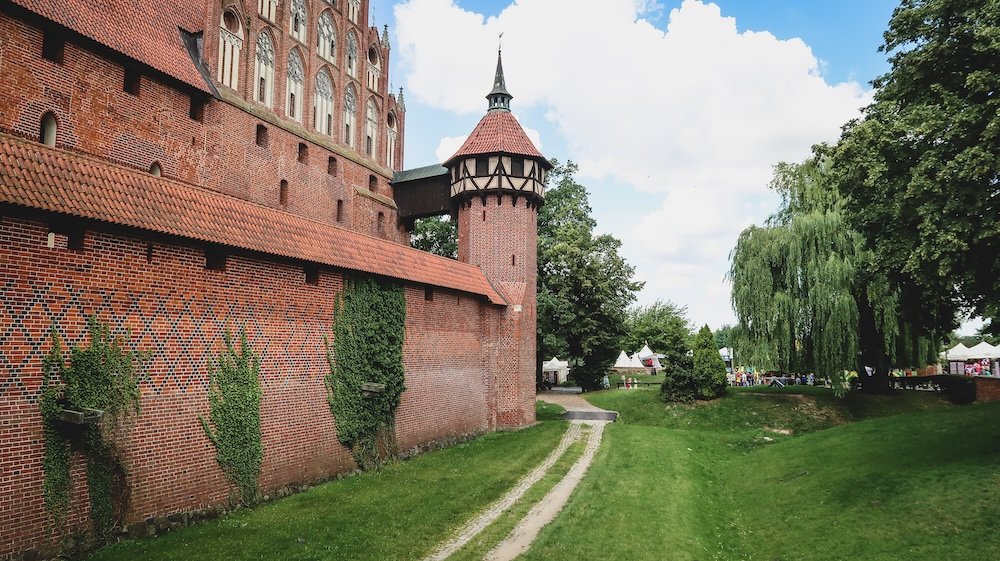
Medieval Charm?
Whether or not you’re a castle connoisseur – Malbork suits you. Families enjoy interactive exhibits; couples might find romance strolling along the Nogat at sunset; history buffs lose themselves in the fortress’s storied halls. Even budget backpackers can find hostels and do day trips without breaking the bank. If you love a dash of medieval grandeur layered with everyday Polish life, you’re in for a treat.
Our Travel Video (Visiting Malbork Castle On A Day Trip) on Samuel and Audrey YouTube Channel: That Backpacker + Nomadic Samuel
Malbork stands tall on the Polish map for good reason. Its towering red-brick castle has witnessed chapters of power shifts and cultural evolution, inviting modern-day visitors to explore epic courtyards, hidden chambers, and scenic riverbanks. Ahead, we’ll guide you through the Top 10 Things To Do, gastronomic delights, recommended tours, where to crash for the night, possible day trips, transport details, and final reflections. Ready to unlock Malbork’s medieval charm? Let’s get to it.
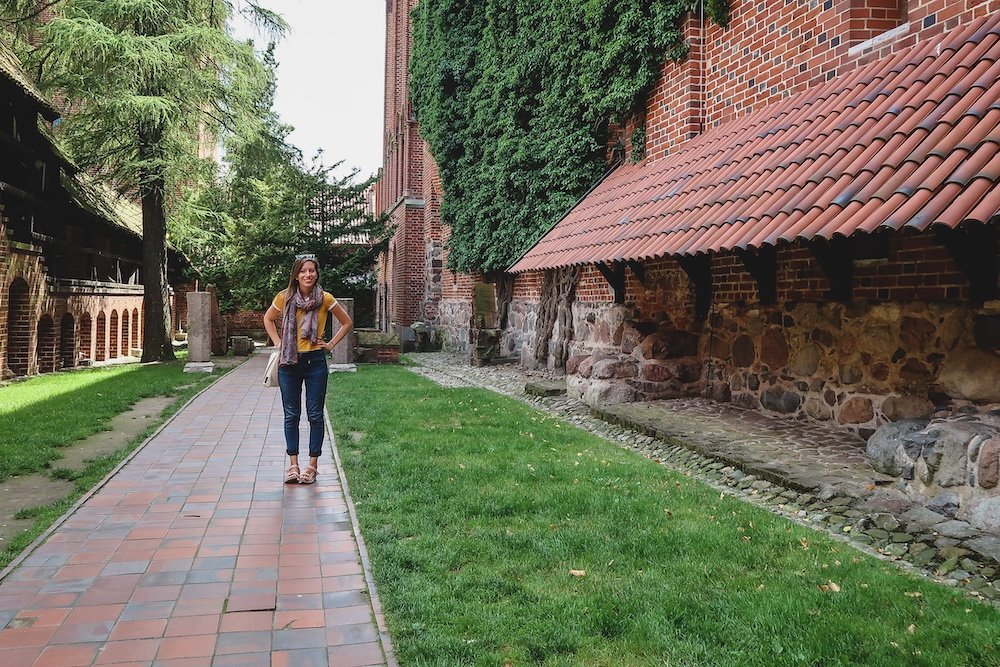
Top 10 Things To Do in Malbork, Poland For Visitors
Malbork might be famous for its colossal fortress. But there’s more beneath the surface. From exploring the castle’s labyrinthine halls to savoring riverside strolls, here are ten can’t-miss things to do to ensure you see Malbork at its best.
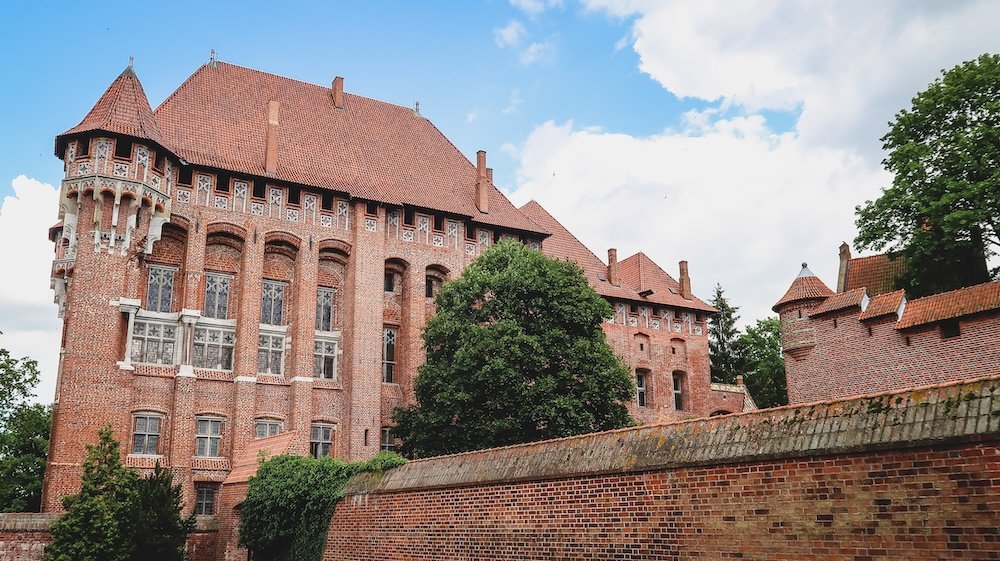
1) Marvel at Malbork Castle’s Grand Exterior
Standing before Malbork Castle, you’ll immediately sense its scale. Constructed mainly of red brick, it’s often hailed as the largest castle in the world by surface area—a massive testament to Teutonic Knight ambition. Before venturing inside, circle around the fortress moat and outer walls. Each gatehouse exudes centuries of warfare tales, while the Nogat River meanders quietly beside. Photographers often linger here at dusk, capturing the fortress silhouetted against fiery skies. It’s a breathtaking preview of the medieval marvel that awaits within.
- Architecture: Blends Gothic arches, thick buttresses, and layered defensive perimeters.
- Best Photo Angles: Across the river near the footbridge—catch the entire fortress mirrored in the water.
- Crowd Tip: Summer afternoons see large groups; earlier mornings or late evenings are calmer.
Tip: Spend 15–20 minutes roaming the exterior to appreciate the castle’s staggering scale before diving into interior tours.
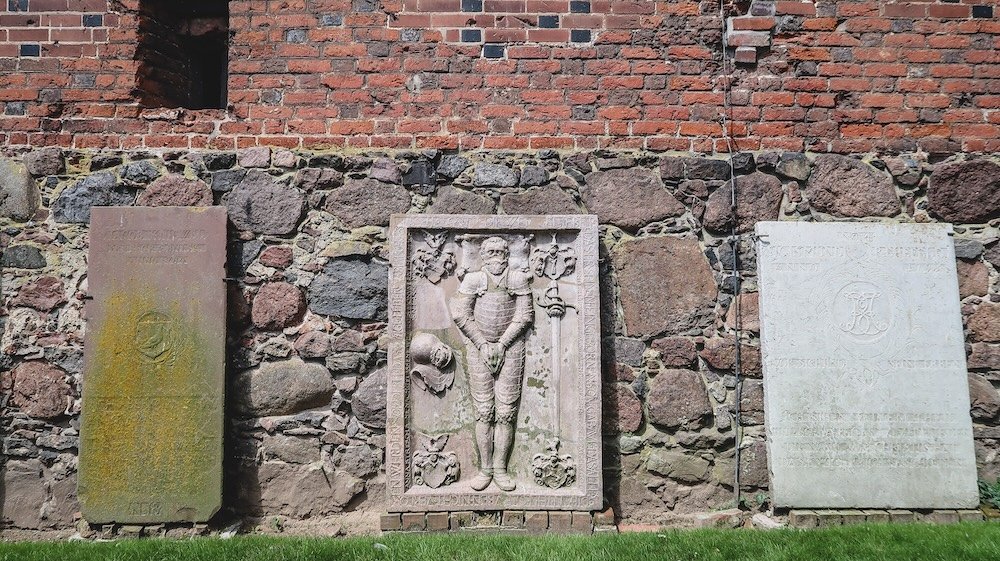
2) Delve into the Castle’s High, Middle, and Lower Complexes
Inside, the Malbork Castle splits into three main sections: High Castle, Middle Castle, and Lower Castle. The High Castle once served as a monastic seat, with austere corridors and the majestic Grand Refectory. Move to the Middle Castle to find living quarters that once housed knights, plus chapels adorned with historical relics. Down in the Lower Castle, stables and workshops thrived, showcasing how everyday tasks kept the fortress operational. Wandering each zone, you’ll sense a shift in ambiance—from solemn prayer halls to bustling administrative hubs. The layered layout underscores the Teutonic Knight hierarchy and intricate castle life.
- Time Estimate: You’ll want 2–3 hours to properly see each sector.
- Audio Guides: Thorough narratives available in multiple languages, clarifying which area you’re in.
- Accessibility: Some older staircases lack full accessibility—wear comfy shoes and be cautious on uneven steps.
Tip: Begin at the High Castle while your energy is fresh, saving the less intricate Lower Castle for last.

3) Book a Guided Tour for In-Depth Stories
Sure, self-guiding works, but a guided tour unravels deeper insights. Guides weave dramatic tales of Teutonic Knights forging alliances, defending the fortress, or hosting lavish feasts in vast halls. You might gain access to hidden chambers typically off-limits, or see restored frescoes up close. They’ll emphasize the fortress’s strategic significance: how the river aided commerce and how massive storerooms sustained knights during sieges. Expect lighthearted anecdotes, too—like rumored ghosts said to roam hallways. After two or so hours, you’ll leave with castle trivia that standard signage can’t match.
- Language Options: English, German, sometimes Spanish or Russian.
- Group Size: Ranges from 10–25 people; smaller tours feel more intimate.
- Scheduling: Busy seasons see tours departing every 30–60 minutes—reserve a spot if you have tight timings.
Tip: Ask about night tours—occasionally, Malbork offers evening experiences with atmospheric lighting.
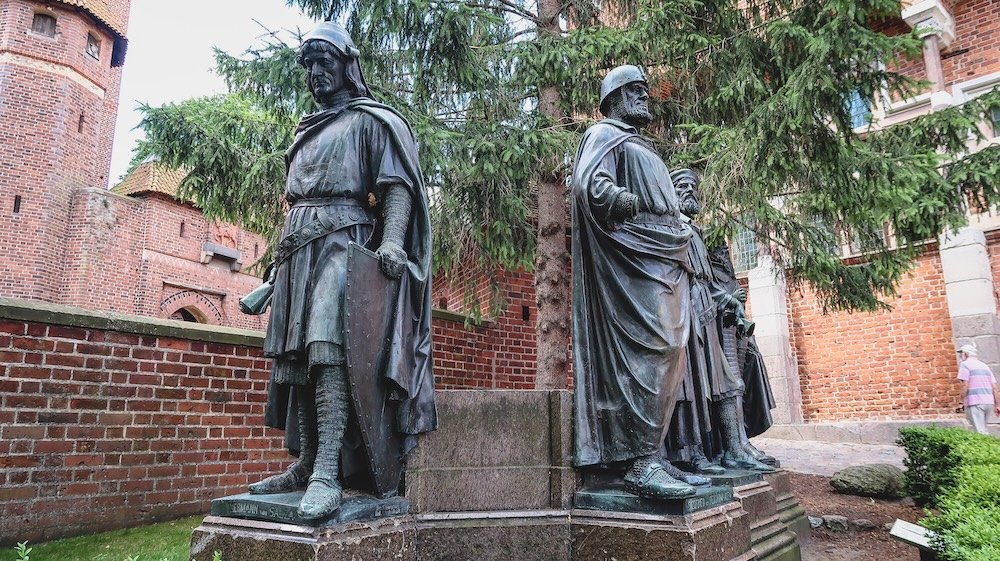
4) Discover the Castle’s Art and Museum Exhibits
Within the fortress, multiple museum exhibits spotlight medieval artifacts, from detailed weaponry to religious icons. Glass cases reveal centuries-old swords, spears, and suits of armor, hinting at the region’s warlike past. Another gallery might showcase delicate ceramics or household wares, illustrating day-to-day life behind towering walls. You could stumble upon cryptic old manuscripts or intricate stained-glass segments rescued post-war. The museum also highlights restoration efforts after WWII damage, underscoring how Malbork resurrected from rubble. It’s a journey through both flamboyant chivalry and mundane routines that shaped the fortress’s essence.
- Entry: Often included in castle tickets, though special exhibits might require a small surcharge.
- Photography: Usually allowed without flash, but watch for restricted zones.
- Interpretation: Bilingual signage or audio support helps you appreciate each display’s context.
Tip: Don’t rush—each hall can devour your time if you’re a history lover, so plan extra minutes for exhibits.
5) Attend Medieval Festivals or Re-Enactments
Throughout the year, Malbork Castle hosts medieval festivals that bring the complex roaring back to the 14th century. Knights in chainmail clash in friendly jousts, blacksmiths hammer away at glowing forges, and vendors sell crafts reminiscent of bygone trades. Music from lutes or bagpipes drifts across courtyards, setting a festive mood. Food stalls tempt you with roasted meats, spiced honey mead, and robust bread—perfect after castle climbing. Interactive corners allow kids (and curious adults) to try archery or watch falconry displays. It’s a living tapestry of old customs, letting visitors see more than static walls.
- When: Summer months or specific historical anniversaries are prime festival times.
- Check Schedules: Timetables might differ yearly; official websites or local tourist offices keep you updated.
- Crowd Factor: These events can be packed, so pre-book tickets if possible.
Tip: Arrive in costume—some events encourage visitor cosplay, adding fun immersion for the whole family.
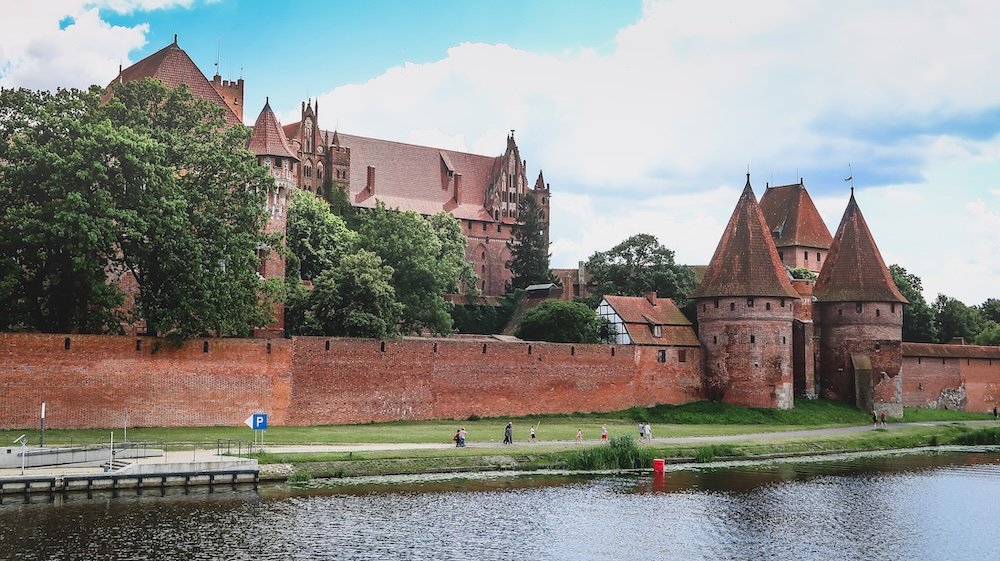
6) Stroll the Nogat Riverbanks
Beyond the fortress, the Nogat River carves a picturesque route around Malbork. A riverside path invites you to wander amid tranquil waters, with the castle’s silhouette standing tall upstream. Local anglers might dot the banks, hoping for a fresh catch. Benches beckon for scenic breaks, especially at dusk when the fortress glows under floodlights. You can also find small boat tours that circle the fortress from the water, granting fresh angles of Malbork’s layered architecture. The calm vantage contrasts the grand interior—giving your day an easy, peaceful interlude.
- Boat Tours: Some operators run short 30–60 minute rides; check times near the quay.
- Wildlife: Swans, ducks, and occasional herons inhabit this watery corridor.
- Tip: The riverside is prime for evening photos if you like capturing reflections of the lit-up castle.
Tip: Pack a mini-picnic—enjoy local snacks or fruit while gazing at the fortress from a quiet riverside spot.
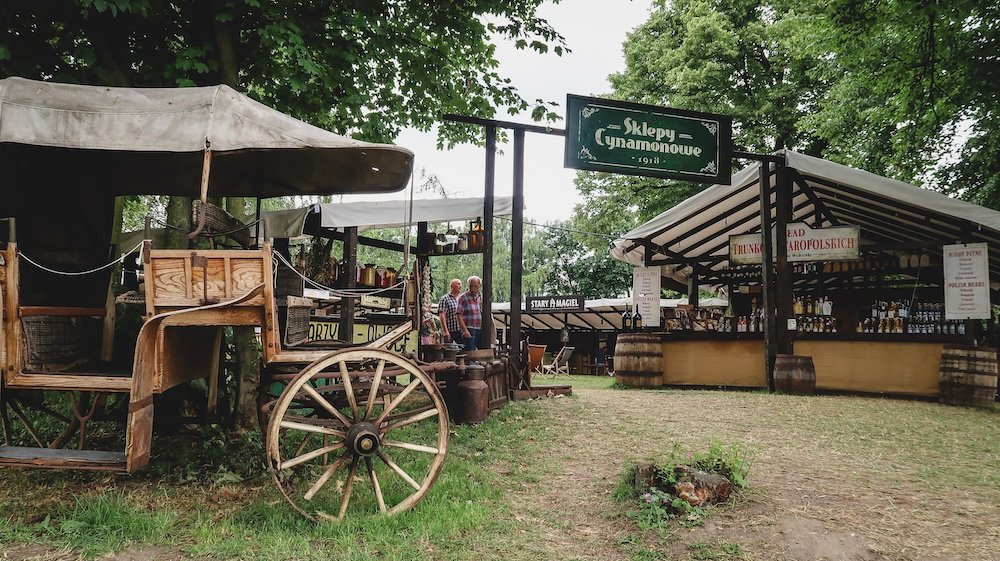
7) Explore Malbork Town Center & Amber Shops
Away from the castle, Malbork’s town center holds cozy streets and a smattering of shops and cafés. While not sprawling, it boasts local bakeries for sweet pastries, plus restaurants where you can sample Polish staples like pierogi or bigos. Some shops feature amber jewelry—fitting, given the Baltic region’s amber heritage. If you’re seeking souvenirs, hand-carved wooden crafts, embroidered linens, or small castle-themed trinkets might catch your eye. The vibe is laid-back, lacking the big-city bustle but offering a genuine taste of local life. Wandering these streets underscores Malbork as more than a fortress—it’s a living community with everyday rhythms.
- Market Days: Occasionally, farmers or craftsmen set up stalls with fresh produce or handcrafted items.
- Historic Landmarks: The old town hall or small chapels can appear as pleasant surprises.
- Tip: Some cafés display fortress views from their terraces—worth a coffee break for a scenic moment.
Tip: Try local sweets—like drożdżówka (Polish yeast pastry) or pączki (doughnuts)—to keep your energy high.
8) Check Out the Castle’s Nighttime Illumination
After sunset, Malbork Castle transforms under a mesmerizing illumination scheme. Floodlights accentuate the red brick towers, creating dramatic shadows across ramparts. Strolling along the river or vantage points near the gates yields a magical sight: the fortress seems poised for a medieval ball. Photographers relish the chance to capture moody silhouettes or glowing reflections in the water. Even if you’ve explored the castle by day, seeing it alight at night feels like encountering a wholly new dimension. Pair it with a late dinner in town, rounding out an enchanting evening.
- Viewing Spots: By the Nogat, from local bridges, or across the fortress moat area.
- Timing: Lights often switch on around dusk; confirm if special shows accompany certain nights.
- Tip: Low-light photography needs a steady hand or tripod to snag crisp images.
Tip: Bring a light jacket—even summer nights can get cool near the river.
9) Visit the Malbork Castle Museum Events & Exhibits
Throughout the year, the Castle Museum organizes rotating exhibitions or cultural events. One month, you might see a medieval weaponry showcase; another month, an art exhibit exploring the castle’s post-war restoration. Sometimes they host lectures, workshops, or film screenings linking Malbork’s medieval heritage to modern artistry. These events often attract local historians, students, and curious tourists, creating an engaging community vibe. Check the museum’s calendar if you want to delve deeper than standard fortress tours. It’s a chance to see Malbork remain relevant through fresh, interactive programming.
- Language: Some events are Polish-language only; inquire if an English translator or summary is available.
- Admission: May be separate from the main castle ticket—ask or check posted notices.
- Tip: Some workshops allow hands-on activities, like mock calligraphy or mini tile painting.
Tip: Grab a schedule when you buy your ticket—these smaller events can surprise you in delightful ways.

10) Savor Riverside Restaurants & Local Beers
Post-adventure, treat yourself at riverside restaurants dotted around Malbork’s scenic edges. Imagine a hearty Polish dinner—think smoked fish or pork cutlets—while the Nogat’s calm current drifts by. Some eateries highlight medieval-themed décor or menus referencing the castle’s knightly past. If beer’s your style, local Polish lagers or craft brews pair wonderfully with that bigos or schnitzel. For those preferring a lighter sip, fruit-infused compote or herbal teas might round out the meal. Between fresh air and fortress views, dining near the water is both calming and fulfilling.
- Outdoor Seating: Great in summer, but bring a sweater for cooler evenings.
- Desserts: Sernik (cheesecake) or szarlotka (apple pie) can wrap up the day sweetly.
- Tip: Some restaurants offer deals if you show same-day castle ticket stubs—worth asking.
Tip: Time your dinner so you can watch the fortress lighting up across the river, a perfect finishing touch to the night.

What To Eat and Drink in Malbork, Poland
Roaming Malbork’s medieval corridors can build an appetite. If feasting on hearty soups, pierogi, or flavorful fish tickles your fancy, consider these things to do for your palate.
Polish Comfort Classics
- Pierogi: Stuffed dumplings with fillings like potato-cheese (ruskie), ground meat, or mushrooms. Typically served topped with fried onions, adding an irresistible crunch.
- Bigos: A stew mixing sauerkraut, fresh cabbage, sausage, and meats—slow-cooked to fuse tangy, savory notes.
- Gołąbki: Cabbage rolls filled with spiced meat and rice, drenched in a tomato-based sauce.
These dishes reflect Poland’s tradition of robust, home-cooked meals that warm you from the inside out. Perfect for chilly evenings after fortress tours. Many restaurants near Malbork Castle highlight these classics alongside modern variations.
Tip: Sample a pierogi platter letting you taste multiple fillings in one sitting.
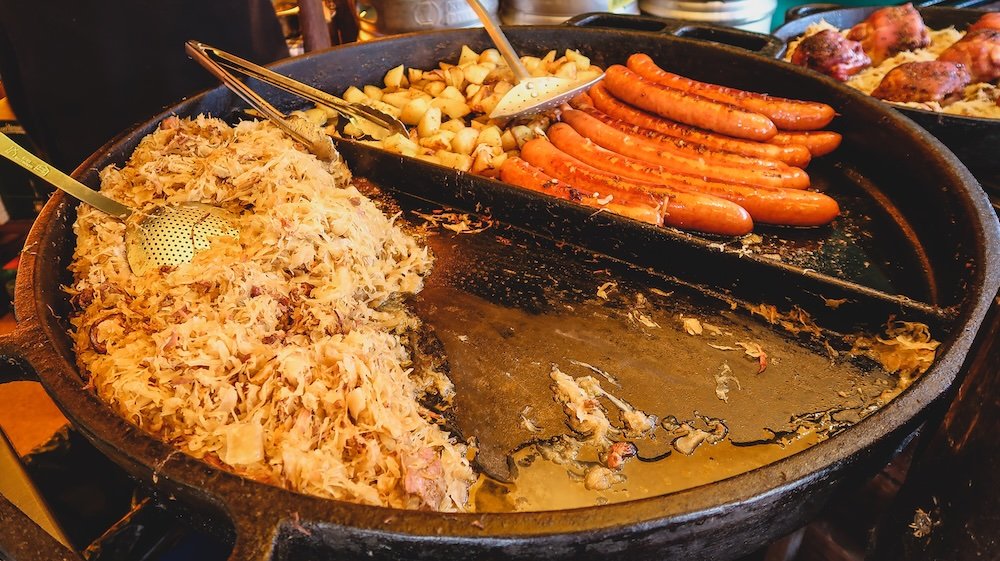
Baltic & River-Inspired Fare
Given Malbork’s proximity to the Nogat River and the Baltic Sea, fish can feature heavily on menus. Fried zander (sandacz) or trout might appear, accompanied by local produce. If you fancy something more adventurous, herring—marinated or in cream sauce—often emerges as a tangy appetizer. Some places also serve fish soups or chowders, bridging local catch with aromatic herbs. These offerings pay homage to the region’s watery environs, bridging medieval seafaring days with modern tastes.
Tip: Seek daily fish specials—restaurants often spotlight the freshest catch from morning markets.
Soups & Street Snacks
Polish soups are a staple: Żurek (sour rye soup) packs smoky sausage chunks in a tangy broth, occasionally served in a bread bowl. Barszcz (beetroot soup) can be clear or creamy, sometimes accompanied by dumplings called uszka. Street stalls might hawk zapiekanka—a baguette loaded with mushrooms, cheese, and optional extras. For a quick midday fix, these open-faced melts hit the spot. Meanwhile, bakeries produce fresh bread or pastries that complement these hearty bowls or on-the-go bites.
Tip: Try soups as starters—they’re often so filling you might scale back your main course portion.
Desserts & Sweet Treats
Polish sweets cater to those with a sweet tooth. Sernik (cheesecake) is lighter than American versions, often with a mild tang. Apple pie or szarlotka also pops up, typically dusted with powdered sugar or paired with whipped cream. If you spot Makowiec (poppy seed roll) in local bakeries, don’t miss it—rich, nutty, and perfect with coffee. On a hot day, snag an ice cream near the castle or a riverside stand. While simple, these desserts bring a comforting end to your Malbork culinary exploration.
Tip: Sample Pączki (Polish doughnuts) in the morning—bakeries can sell out by midday.
Drinks & Refreshments
- Beer: Polish lagers (Tyskie, Żywiec) or smaller craft brews.
- Vodka: A local staple—try fruit-infused or herbal varieties. Żubrówka (bison grass vodka) merges a grassy note with crispness.
- Compote: A non-alcoholic brew of boiled fruits, sweet and refreshing—common in casual eateries.
Tip: If sampling Polish vodka, do so responsibly—a small shot can be strong but rounds out a hearty meal.
Dining Tips & Ambiance
Malbork restaurants near the castle often adopt medieval accents—dim lighting, knight-themed décor, maybe even staff in costume. Others keep it straightforward, focusing on honest cooking and direct river views. Summer sees more terrace dining, letting you enjoy the castle silhouette at dusk. Reservations aren’t always essential, though peak times might see crowds, especially during festivals. If you’re on a budget, local milk bars or small bistros can feed you well without draining your wallet.
Tip: Engage staff—many speak basic English or have English menus, so don’t hesitate to ask for dish recommendations or ingredient clarifications.

Tours For Visitors To Malbork, Poland
While Malbork Castle anchors most itineraries, guided tours can elevate your experience from a simple look-around to a richly layered exploration. Below are recommended things to do for travelers seeking deeper insights, local anecdotes, or specialized vantage points.
1) Full-Day Castle Immersion Tour
You can wander the castle alone, sure—but a full-day immersion digs into nooks often missed by casual visitors. Your guide reveals secret staircases, lesser-known exhibits, and behind-the-scenes lore about medieval life. Expect historical tidbits on each courtyard, from the High Castle’s monastic hush to the Middle Castle’s more administrative vibe. Extended tours sometimes grant access to private chapels or treasury chambers with rare artifacts. You’ll pause midday for lunch (maybe in a period-themed hall or a courtyard café), fueling you for the next layers of fortress wonders. By day’s end, you’ll have a comprehensive grasp of Malbork’s architecture, politics, and cultural tapestry.
- Booking: Through official castle channels or specialized agencies—reserve in advance for guaranteed spots.
- Time: 6-7 hours total; stamina recommended for all that walking.
- Tip: Some tours bundle in a local dinner or post-tour reflection session.
Tip: Wear comfy shoes—Marathon-level exploring demands stable footing on cobblestones and steep steps.
2) Night Tour & Light Show
When dusk cloaks Malbork, an evening castle tour conjures a moody aura. Guides lead groups by torchlight or subtle floodlights, spinning stories of battles, ghosts, and clandestine intrigues. The walls seem taller, the courtyards eerily quiet, making each footstep echo ominously. Occasionally, an orchestrated light show illuminates ramparts in shifting color patterns, accompanied by dramatic music that recounts pivotal historical episodes. This spectacle marries entertainment with history, leaving visitors enthralled. If you crave theatrical flair, the night tour is an unforgettable highlight.
- Seasonality: Common in summer or special events; check official schedules.
- Atmosphere: Tense yet mesmerizing—perfect for adventurous couples or older kids.
- Tip: Some tours end with a falconry display or costumed performance.
Tip: Pack a light jacket—even warm days can turn chilly in the open-air courtyards at night.

3) Audio Guide with Flexible Pace
For travelers preferring an audio guide to a live group, Malbork Castle’s official devices strike a solid balance. You’ll hear layered commentary: architectural breakdowns, tidbits on Grand Masters, or how Teutonic Knights structured their day. Each station often includes optional deep dives—skip them if short on time, indulge if you’re enthralled. This approach suits those wanting autonomy in each hall, yet still gleaning curated knowledge. You can pause at scenic corners, reread map details, or chat with companions. The freedom is appealing, especially if you prefer forging your own path minus the hustle of a guided cluster.
- Availability: Usually in multiple languages (Polish, English, German, etc.).
- Device: Handheld or smartphone app—check battery life!
- Tip: If you prefer quiet reflection, lower volume or use one earpiece only.
Tip: Test track #1 near the entrance to ensure the audio matches your language selection.
4) Malbork & Gdańsk Combo Tour
Some operators bundle Malbork Castle with a quick Gdańsk Old Town visit. You’ll start the morning in Malbork for a guided fortress exploration, then board a comfortable coach or minivan to Gdańsk. Once there, another guide leads you through major highlights—Neptune’s Fountain, St. Mary’s Basilica, or the historic crane by the river. It’s an efficient way to see two iconic Polish jewels in a single day, especially if your schedule is tight. The synergy of medieval fortress might and a Hanseatic port’s charm enriches your knowledge of northern Poland’s layered heritage.
- Transit: Often an hour by road between Malbork and Gdańsk.
- Lunch: Some tours plan a lunch stop in between or near Gdańsk’s city center.
- Tip: Check if the package covers all admission fees or if you’ll pay extras at each location.
Tip: Limit your luggage—bouncing between sites is simpler with a small daypack.
5) Local Culinary & Market Excursion
For a taste of Polish daily life, a culinary tour merges fortress tales with local market stops. You’ll roam small produce stands or shops near Malbork’s town center, sampling fresh cheeses, cured meats, or pickled goodies. Guides share insights on regional flavors—like how the Baltic influences fish dishes or how local farmers supply vegetables. You might then pop into a family-run restaurant for a quick cooking demo: kneading dough for pierogi, learning to sauté mushrooms, or watching jam bubble in a pot. Tasting each product while hearing its story fosters a deeper bond with Malbork’s gastronomic soul.
- Duration: 2–4 hours, typically including multiple tasting stops.
- Vegetarian Options: Usually arranged if you inform the operator in advance.
- Tip: Some tours conclude at a cozy café or local microbrew pub for a final indulgence.
Tip: Start hungry—the array of bites can build to a full meal’s worth of sampling.
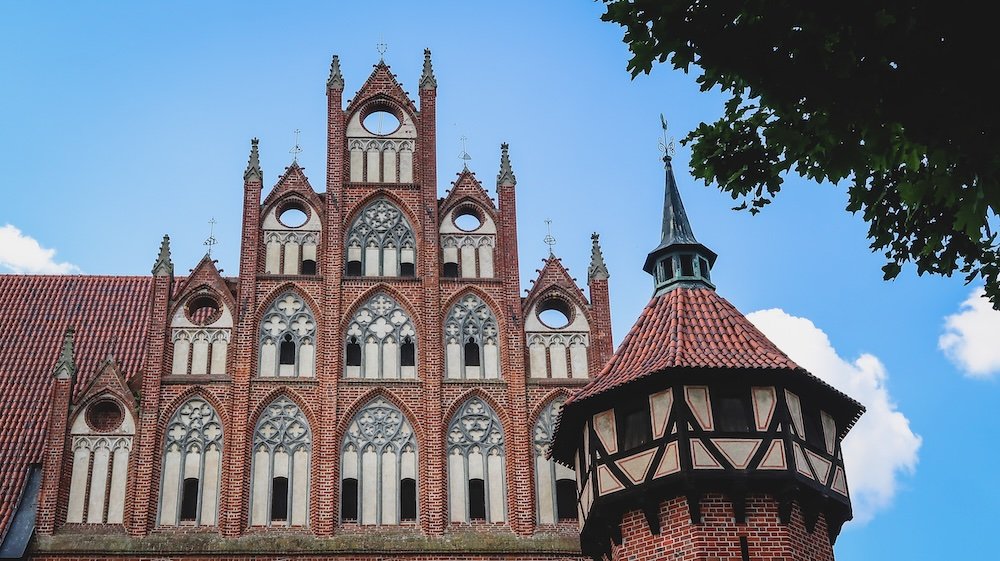
Malbork Accommodations Guide: Hotels, Guesthouses and Hostels
Choosing where to stay in Malbork often hinges on how close you want to be to the fortress or if you prefer quieter outskirts. This guide outlines the main lodging options—covering hotels, guesthouses, and budget-friendly spots—to help you find the right base for your things to do in Poland’s medieval hotspot.
Hotels
Malbork’s hotels split between riverside locales offering fortress views and those nestled in the town’s modern sections. Some higher-end picks blend stylish interiors with castle-themed décor touches, echoing the area’s knightly roots. Look for on-site dining, possibly serving Polish or international fare, plus standard amenities like Wi-Fi, air conditioning, or 24-hour reception. Mornings might bring a buffet brimming with local bread, jams, cold cuts, and cereals. Proximity to Malbork Castle can be a boon—walk out the lobby, and you’re a short stroll from those iconic red bricks. Summer sees rates climb, so booking a few months ahead is wise if you want prime views or weekend stays.
- Budget Range: Expect €50–€80 for mid-range, ~€100+ for upscale near the castle.
- Parking: If driving, check if the hotel includes free or paid parking.
- Tip: Some top-tier hotels offer fortress tour partnerships—ask if package deals exist.
Tip: Request a “castle view”—these coveted rooms can vanish fast in peak seasons.
Guesthouses & B&Bs
For travelers who crave personal warmth, guesthouses and B&Bs deliver cozy rooms and local hosting. Interiors might sport vintage furnishings—wooden floors, lace curtains, or regionally inspired art. Breakfasts often involve homemade pastries or eggs from local farms, letting you savor Malbork’s produce from the get-go. Many hosts speak basic English and share insider tips on best dining corners or scenic back alleys. The pace is relaxed, encouraging you to chat in living rooms or back gardens. You’ll likely walk away feeling part of the neighborhood, not just a passing tourist.
- Average Rates: ~€35–€60 per night, slightly higher if near the castle.
- Children-Friendly: Some owners happily accommodate families with extra cots or play areas.
- Tip: If you desire longer stays, guesthouses can be flexible on pricing—negotiate a discount.
Tip: Confirm breakfast hours—some hosts set a strict window, but it’s usually worth rising early for the fresh goodies.
Hostels & Budget Lodging
If your priority is minimal lodging cost, hostels or small budget inns come to the rescue. Expect dorm-style bunks or simple private rooms with shared bathrooms. Common areas foster a social atmosphere, letting you connect with fellow travelers who might join you for fortress tours. Some hostels also run group outings or pub evenings, bridging language barriers with a communal vibe. Because Malbork is smaller, hostels might be limited—so if you see one that fits your timeframe, book soon. This route suits backpackers, students, or budget-savvy explorers who prioritize experiences over plush amenities.
- Price: ~€10–€20 per dorm bed, ~€30–€40 for private doubles if available.
- Facilities: Communal kitchen, lounge, free Wi-Fi, possible lockers.
- Tip: Bring earplugs—dormmates might chat late or return from night tours in spirited moods.
Tip: Look for “free breakfast”—some hostels sweeten the deal with coffee, tea, or basic morning spreads.
Apartments & Vacation Rentals
For a sense of independence, consider apartments or vacation rentals. They’re scattered around Malbork, from near the castle to quieter suburban zones. Enjoy kitchens for cooking your own meals (handy if you want to experiment with Polish groceries) and living rooms for extra space. Families or groups often save money by splitting costs, especially for multi-bedroom setups. However, note check-in procedures: some owners use self-check-in, so coordinate arrival times carefully. This approach merges privacy and local living, letting you slip into Malbork’s day-to-day rhythms.
- Platforms: Airbnb, Booking, or local rental sites.
- Duration: Perfect for extended visits or if you want a “home base” for day trips.
- Tip: Some apartments boast castle views from balconies or top-floor windows.
Tip: Verify parking or public transport if the rental sits outside central Malbork—no one loves a surprise long walk at midnight.
Seasonal Booking Tips
Malbork hits peak visitor numbers in summer, especially July-August. Castle events, re-enactments, and warm weather bring crowds, so lodging can vanish fast. Book 2–3 months in advance if you’re picky about location or want a weekend. Winter sees fewer tourists, meaning potential bargains, though some smaller guesthouses might close or limit hours. Decide if you fancy the lively festival buzz or prefer a mellow off-season vibe, then plan your reservation timeline accordingly.
- Deals: Shoulder months (May, September) can yield moderate rates plus decent weather.
- Events: For major medieval festivals, lodging can sell out, so jump on early bird deals.
- Tip: Keep an eye on cancellation policies—flexibility matters if your plans shift.
Tip: Contact properties directly—some smaller B&Bs offer better rates when avoiding booking platform fees.
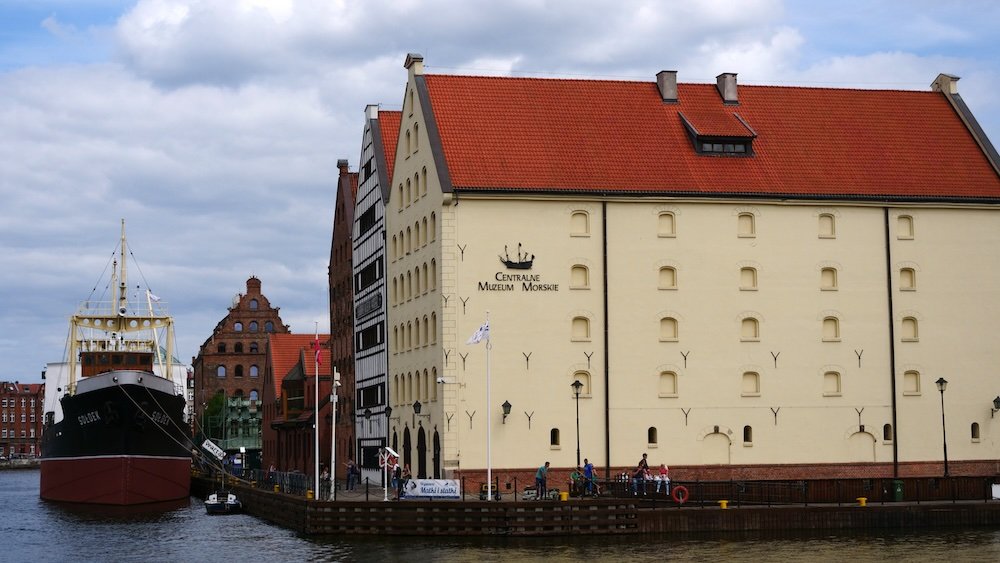
Day Trips From Malbork, Poland
While Malbork captivates with its monumental castle, the surrounding region offers rewarding things to do on day trips that expand your northern Poland adventure. Here are five suggestions, each revealing a different facet of the area’s culture or scenery.
1) Gdańsk: Medieval Marvels & Seaside Charm
Just a quick 30–40 minute train ride from Malbork lies Gdańsk, a city famed for its Hanseatic heritage and maritime flair. Stroll the Long Market (Długi Targ) under colorful townhouses, with Neptune’s Fountain marking the historic center. Explore St. Mary’s Basilica, one of Europe’s largest brick churches, or pop into the Crane (Żuraw) museum. By the Motława River, restaurants serve Baltic fish and local craft beers—perfect for midday refueling. End at the European Solidarity Centre, gleaning insights into Poland’s modern democratic transformations. Gdańsk merges medieval ambience with a dynamic modern pulse that complements Malbork’s fortress appeal.
- Transport: Frequent trains, ~€3–€5 each way, or a ~1-hour car drive.
- Activity: Check if a short boat cruise or a walk to Mariacka Street’s amber shops fits your day.
- Tip: Mornings see fewer crowds—arrive early to explore Old Town in peace.
Tip: Pair Gdańsk with a quick side trip to Westerplatte if WW2 history intrigues you.
2) Elbląg & Its Canal Wonder
Elbląg, about 40–50 minutes from Malbork by train or bus, tempts travelers with a canal system showcasing engineering brilliance. The Elbląg Canal allows boats to “ride” on tracks over land between water segments—unique worldwide. Stroll Elbląg’s Old Town, smaller but reminiscent of Gdańsk’s architecture, with reconstructed houses echoing medieval roots. Local cafés might serve tasty pączki (Polish doughnuts) for a sweet break. If canal tours run, climb aboard to watch your boat traverse grass stretches, a surreal “ship-on-land” spectacle. The day wraps with a sense of quiet discovery rarely found in busier tourist hubs.
- Time: Plan 4–6 hours if you do the canal ride plus Old Town walk.
- Photography: The canal’s slipways are prime vantage points.
- Tip: Summer is best—canal operation can be limited in cooler months.
Tip: Bring a windbreaker—sailing segments might be breezy, even if inland air is still.
3) Sztum for a Quaint Castle Experience
Sztum, a half-hour drive south of Malbork, boasts a smaller Teutonic castle and a gentle lakeside. Though overshadowed by Malbork’s grandeur, it’s worth a half-day trip for a quieter fortress vibe. Wander the castle’s modest courtyard, appreciate historical exhibits, or climb short towers for local panoramas. The adjoining lake invites strolls or even kayaking in warmer months. A handful of local eateries ensure a calm midday break, away from the bustle of Malbork’s main tourist zone. If you’re a fortress enthusiast, comparing Sztum’s simpler design to Malbork’s colossal structure can be enlightening.
- Public Transport: Limited direct buses—renting a car or taxi is simpler.
- Admission: Lower cost than Malbork, though less elaborate tours.
- Tip: Check event schedules—Sztum occasionally hosts small medieval fairs too.
Tip: Combine with orchard stands in the countryside if you love picking fresh fruit.
4) Tczew’s Bridges & Vistula Museum
Tczew, around 25 minutes by train, merges modern expansions with historical architecture. The highlight is its iconic bridge—one of Europe’s oldest metal spans, partially in ruins but photogenic. The Vistula Museum (Muzeum Wisły) offers insights into Poland’s largest river, touching on trade, ecology, and local maritime traditions. A short walk through Tczew’s center reveals neat squares, churches, and perhaps a market if you time it right. It’s less touristy than Gdańsk or Elbląg, which can feel refreshing. If you want a day of subdued sightseeing plus an educational twist, Tczew fits the bill.
- Cuisine: Local bistros serve standard Polish fare—pierogi, schnitzel, soups.
- Bridge Access: Some sections are closed for restoration; read signs carefully.
- Tip: The museum can be done in an hour or so—great for an afternoon trip.
Tip: Aim for early afternoon—morning might be quiet, but you’ll want sunlight for crisp bridge photos.
5) Kashubian Lake District Retreat
For nature lovers, the Kashubian Lake District beckons about an hour or so away from Malbork by car. The rolling hills, dense forests, and tranquil lakes reveal Poland’s rural soul. You can rent a canoe, fish, or cycle along scenic roads, pausing for village charm. If you’re keen on local culture, watch for Kashubian embroidery or distinctive pottery. Some tours incorporate homestays or B&B experiences, letting you taste homemade bread, jam, or smoked sausage. This day trip slows your pace, offering a deeper exhale after Malbork’s fortress intensity.
- Transport: Easiest by car—public buses exist but are sporadic.
- Activities: Boating, hiking, or visiting small crafts shops.
- Tip: Speak to local B&B owners—they might reveal hidden vantage points or local festivals.
Tip: Carry Polish zloty—rural shops or farmers’ stands may not accept cards.

Malbork Transportation Guide
Navigating Malbork—and linking it to broader Polish destinations—can initially seem daunting, but it’s simpler than you might think. With a bit of planning, you’ll shuffle between castle tours, nearby day trips, and even a quick Gdańsk run without stress. Here’s a rundown of how to approach Malbork’s transport scene, aligning with your things to do itinerary.
Trains
Malbork’s train station (Malbork Główny) anchors travel to and from big Polish cities, particularly Gdańsk, Tczew, Warsaw, and beyond. PKP Intercity handles intercity lines with comfortable compartments—tickets can be pre-booked online or purchased at station kiosks. For local hops (like Gdańsk), the regional PolRegio or SKM lines serve frequent daily schedules. The ride from Gdańsk typically takes 30–40 minutes, fairly straightforward for day trippers or returning visitors. If you’re heading east or south, just confirm if your train stops at Malbork or if you need to transfer at a hub like Tczew. Plan to arrive at the station 10 minutes ahead—platform announcements can change last minute.
- Fare Range: ~€3–€5 for short local journeys, more for intercity routes.
- Peak Times: Early mornings or late afternoons see commuter rush; midday can be calmer.
- Tip: Some express trains skip small stops—check the route list to ensure Malbork is included.
Tip: Validate your ticket or check seat reservations if traveling intercity—PKP can be strict with fines.
Buses
Buses can fill transport gaps. Especially to smaller villages or regions less connected by rail. The main bus station near Malbork’s center posts timetables—some lines head to Elbląg, Tczew, or rural spots. Buses aren’t as frequent as trains, so check schedules to avoid being stuck. Tickets are sold onboard or at a kiosk, depending on the operator; always carry some zloty in small denominations. Weekend or holiday routes might reduce to skeleton timetables, so confirm details a day before traveling. For short journeys, buses may be an alternative if trains are crowded or timetables don’t match your plan.
- Duration: Bus rides can be slower if roads are congested.
- Luggage: Usually stored undercarriage if it’s a larger coach, or overhead for small bags.
- Tip: Some local lines only have Polish signage—knowing key place names helps.
Tip: Ask drivers about return schedules; the last bus can leave earlier than you expect.
Car Rental & Driving
If you desire autonomy, car rental from Gdańsk or local agencies sets you free from rigid train times. The A1 motorway near Tczew or local highways can link you to Malbork swiftly. Parking near the castle or town center can fill up in high season, but typically you’ll find a space or pay-lot with minimal fuss. The advantage: spontaneous side quests to rural corners, the Kashubian Lake District, or orchard stands without waiting for public transport. Downside: traffic can bottleneck near Gdańsk or if an event swells Malbork’s roads.
- Fuel: Gas stations line main routes; pay in zloty or card.
- Speed Limits: ~50 km/h in towns, 90 on open roads, 140 on highways (where indicated).
- Tip: A GPS or offline map is invaluable—some smaller roads lack English signage.
Tip: Check parking fees near the fortress—some zones have time limits or official pay machines.
Taxis & Rideshare
Taxis in Malbork aren’t as abundant as in larger cities, but you’ll find them around the train station or main squares. Fare meters standardly set the price—confirm if the driver uses a meter or a flat rate for certain routes. If your Polish is limited, keep addresses or location names on your phone to show drivers. Ride-hailing apps (Uber, Bolt) might function near Gdańsk but can be spotty in Malbork. For late-night or early-morning journeys, calling a local taxi number (which hotels or guesthouses often provide) ensures you’re not stranded.
- Cost: Short in-town hops cost a few euros; out-of-town runs can be higher, so clarify.
- Language: Some drivers speak English, but be prepared to illustrate your destination on a map.
- Tip: If exploring after dark, arrange a taxi ahead to avoid long waits.
Tip: Carry small bills—not all taxis accept card payments.
Walking & Cycling in Town
Malbork’s compact center and fortress adjacency mean walking is feasible for daily errands or tours. From the train station to Malbork Castle is about a 10–15 minute stroll. If you fancy cycling, check local rentals or see if your accommodation can lend you bikes. Riding along the Nogat River or exploring backstreets offers a relaxed perspective away from the castle’s main crowds. Watch for cobblestone patches near the fortress—slippery in wet weather. Overall, Malbork is no metropolis; pedestrians and pedal pushers can enjoy unhurried exploration.
- Footwear: Good sneakers for the fortress’s uneven surfaces.
- Bike Paths: Limited but functional; caution on shared roads with minimal bike lanes.
- Tip: Early mornings see fewer people—a calm time for scenic strolling.
Tip: Bring a small backpack—toss in water, a snack, and your camera, perfect for an unplanned side trek.
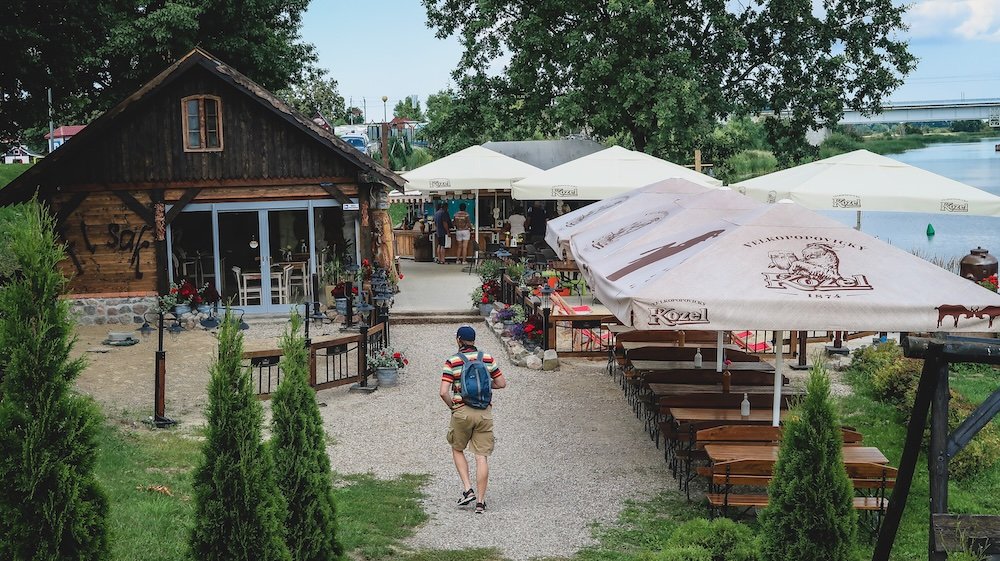
Malbork travel questions answered: castle tips, logistics, seasons & local-style advice
How many days do you really need in Malbork, and is a day trip from Gdańsk enough?
Absolutely. If you’re short on time, a day trip from Gdańsk works really well. The train ride is roughly 25–55 minutes each way, and you can see the castle, stroll the riverfront, and grab a meal in town with a full day on the ground.
If you’re more of a slow-travel person, I’d give Malbork one night. That lets you do the castle at a relaxed pace, circle back for night-time illumination, and maybe squeeze in a riverside walk or a lazy breakfast before heading on. Two nights only really make sense if you’re combining Malbork with a couple of nearby day trips like Elbląg or Tczew and you don’t want to keep bouncing back to Gdańsk.
When is the best time of year and time of day to visit Malbork Castle?
It depends. For weather and light, late May to September is your sweet spot—think mild-to-warm days, long evenings, and a decent chance of blue skies. July and August are the hottest (around low 20s°C on average) but also the busiest, so expect more tour groups. Winters can hover around freezing, with short days and a very different, moody vibe.
In terms of timing, the castle typically opens around 9:00 a.m. in the main season and stays open into the evening, so I like to either rope-drop at opening or go later in the afternoon to dodge the big mid-day waves. In winter, hours are much shorter (roughly morning only), so plan carefully and don’t rock up just before closing.
What is the easiest way to get from Gdańsk to Malbork Castle without renting a car?
Train, hands down. Regular trains run between Gdańsk and Malbork throughout the day, with the quickest PKP Intercity services doing the trip in about 25–34 minutes and slower regional trains taking up to 55 minutes. From Malbork station it’s roughly a 15-minute walk to the castle—basically straight ahead and over.
Budget-wise, expect to pay roughly the cost of a casual lunch for a return ticket, with regional trains usually cheaper than the faster intercity ones. If you don’t feel like figuring out schedules, you can also book an organized day tour from Gdańsk that bundles transport, tickets, and sometimes a guide, but DIY by train is very straightforward.
How much do Malbork Castle tickets cost, and which route should I choose?
Currently, standard “main” tickets for Malbork hover around 80 PLN for adults and 60 PLN reduced, with different routes priced separately. The Historical Castle Route (the big, full experience) takes about 3.5 hours, includes the main interiors, and comes with an audio guide or Polish-speaking guide included. The Castle Grounds Route is cheaper (around 35 PLN), focuses on courtyards and exteriors, and takes roughly 1.5 hours. There’s also a Castle Monastery Route focusing on the oldest high-castle section, usually around 70 PLN and about 2 hours.
If it’s your first time, I’d almost always recommend the Historical Castle Route. That’s where you really feel the scale and story of the place. The shorter Grounds Route is good if you’re on a tight schedule, traveling with small kids, or just not that into interiors. If you’re a hardcore medieval nerd, the Monastery Route is a fun extra layer.
Do I need to book Malbork Castle tickets or tours in advance?
Usually. In peak season (roughly late spring through early autumn, weekends, and school holidays), pre-booking helps a lot—especially if you want a specific timeslot or are traveling as a group. Tickets for the main routes can sell out on busy days, and guided tour slots are limited.
In the quieter months, you can often just turn up and buy at the ticket office, but I still like to at least check the official website beforehand for any schedule changes, special events, or closures. If you’re the type that gets stressed by uncertainty, locking in your ticket and time ahead of the trip is a nice bit of peace of mind.
How long does it actually take to visit Malbork Castle properly?
Realistically, plan for at least 3–4 hours inside the castle complex if you’re doing the full Historical Castle Route. That gives you time to move through the three main sections (High, Middle, and Lower Castle), linger in some of the rooms, and not feel like you’re sprinting from doorway to doorway. Many people, myself included, have spent around four hours on a first visit without getting bored.
Add another hour or so if you want to photograph the exterior from multiple angles, cross the pedestrian bridge for that classic riverside view, and enjoy a relaxed coffee or lunch. If you combine the castle with a slow river walk and dinner in town, you can absolutely turn it into a very full day.
Is Malbork Castle good for kids and families, or will younger children be bored?
Mostly yes. Older kids and teens usually love the sheer size of the place, the weaponry, and the feeling of walking through a “real-life video game castle.” Interactive exhibits and the chance to climb towers or walk over drawbridges help a lot. Medieval festivals and re-enactment days are especially fun family-friendly times to visit.
For younger children, attention spans are the main challenge. The audio guide can be too long-winded, and there’s a fair bit of walking, stair-climbing, and “don’t touch that” moments. I’d keep expectations realistic: plan breaks in the courtyards, carry snacks and water, and be okay with skipping some of the more detailed museum rooms if the little ones start wilting.
How accessible is Malbork Castle for wheelchair users or travelers with limited mobility?
Honest answer: partially. Some parts of the complex have been adapted—ticket offices, some paths, certain toilets, and sections of the grounds and interiors. But at its core this is a huge medieval fortress full of cobblestones, narrow staircases, and uneven floors, and there are limits to how much they can realistically modify.
If you use a wheelchair or have trouble with stairs, you’ll still be able to see the exterior, courtyards, and some interior spaces, but not every tower or exhibit hall. Having a companion to help navigate the bumpier sections makes a big difference. I’d also recommend checking the official site’s accessibility notes just before you go, as they outline which areas are most manageable.
Is Malbork a safe place to visit, and are there any common scams or hassles to watch out for?
Generally, yes—Malbork feels like a very safe small town. Like most of Poland, violent crime against tourists is rare. The main things to watch for are the usual petty-issue suspects: pickpocketing in crowds, especially on busy summer days inside the castle or at the train station, and the occasional overcharging by taxis if you don’t agree the meter/price up front.
Basic common sense goes a long way: keep valuables out of back pockets, double-check you’re using official ticket windows, and be wary of anyone trying to “help” with tickets or ATMs. Overall, though, Malbork is not a stressful destination from a safety standpoint.
What should I wear and pack for a full day exploring Malbork Castle and town?
Comfort first. You’ll be on your feet a lot and walking on cobblestones, stairs, and uneven surfaces, so sturdy sneakers or light hiking shoes are perfect. Inside, temperatures can feel cooler than outside in summer and surprisingly chilly in shoulder seasons, so a light layer is useful.
In summer, pack sunglasses, sunscreen, and a refillable water bottle; in winter, think warm coat, gloves, and hat. A small daypack with water, snacks, and maybe a compact umbrella is ideal. If you’re into photography, this is one of those places where a wide-angle lens earns its keep, especially in courtyards and refectories.
Can I visit Malbork Castle on my own, or is a guided tour or audio guide worth it?
You absolutely can explore on your own, but I actually recommend some sort of guiding. The included audio guide on the main routes is very solid and gives you context for each section, from monastic life to fortress defenses. Many visitors end up using the audio because it’s already bundled into the ticket and it helps make sense of what you’re seeing.
Live guided tours are great if you’re more of a “story person” than a “museum plaque person.” You’ll get anecdotes, legends, and a chance to ask questions. If you prefer full freedom to wander and pause for photos, the audio guide is a nice compromise between structure and independence.
Should I stay overnight in Malbork or base myself in Gdańsk instead?
It depends on your style. If Malbork Castle is your big northern Poland highlight and you want to soak up night-time views, quiet riverside strolls, and maybe a festival or night show, staying one night in Malbork is lovely and less rushed. You’ll also get those early-morning or late-evening windows with fewer people around.
If you prefer a livelier base with more restaurants, nightlife, and alternative things to do, Gdańsk makes the better hub. With fast trains, you can easily day-trip to Malbork and be back in Gdańsk for dinner. Personally, I like doing one Malbork overnight plus a few nights in Gdańsk for the best of both worlds.
Are there vegetarian or picky-eater-friendly food options in and around Malbork Castle?
Yes. Traditional Polish menus lean heavy on meat, but you’ll still find plenty of vegetarian-friendly dishes: pierogi stuffed with cheese and potato, mushroom-based mains, hearty soups, salads, and sides. Near and inside the castle there are cafés and restaurants where you can usually tweak dishes (hold the meat, extra veggies) without too much drama.
For picky eaters, look out for simple grilled meats, schnitzels, fries, and plain pasta-style options. Dessert lovers are well covered—cheesecake, apple pie, and doughnuts pop up often. If you have serious dietary restrictions (vegan, gluten-free, etc.), I’d bring a few backup snacks and learn a couple of key Polish phrases to explain your needs.
Are there luggage storage options in Malbork if I’m traveling with bags?
Conveniently, yes. Malbork’s train station has lockers where you can stash a small or medium-sized bag while you explore, which is perfect if you’re in transit between cities and just hopping off for the day.
At the castle itself, there are cloakrooms/lockers near the ticket area where larger bags are often not allowed inside and must be left. That’s useful if you’re coming straight from the train with a backpack. I’d still keep valuables on you in a small daypack and put only non-essentials in any shared storage.
Are there special events, festivals, or night shows at Malbork Castle worth planning around?
Definitely. One of the big highlights is the historical festival often referred to as the “Siege of Malbork,” a multi-day summer event with medieval re-enactments, workshops, markets, and live performances that bring the castle’s history to life in a very immersive way.
From roughly spring to early autumn, the castle also hosts night-time light and sound shows on selected dates. The walls are illuminated, music and narration tell the story of the fortress, and the whole place feels like a movie set. Schedules change year to year, so I’d check the official site or local tourism info when you’re planning your trip and, if possible, anchor your visit around one of these evenings—the atmosphere is unforgettable.
Malbork Travel Guide: Final Thoughts
Malbork merges the dramatic pull of medieval legend with the approachable charm of a small Polish town. Yet there’s more to Malbork than its famed castle. Stroll away from those towering walls, and you’ll find a community that balances tradition with modern life—cozy cafés, family-run eateries, and quieter side streets where everyday routines unfold.
By now, you’ve seen the things to do: from exploring labyrinthine corridors with or without a guide, to savouring hearty soups or local fish by the river, to venturing into night tours that cast the fortress in a spectral glow. Transport concerns needn’t hinder your plan. With trains whisking you from Gdańsk in under an hour, plus buses or rental cars for flexible jaunts, reaching Malbork is straightforward. Once you’ve settled, lodging options range from comfortable hotels with fortress views to intimate guesthouses run by friendly locals.
Even if time is short, a single day can deliver powerful impressions of the castle’s magnitude. If you can spare two days, you’ll uncover hidden corners, enjoy a leisurely river stroll, and maybe dabble in a medieval festival or re-enactment.
Ultimately, Malbork thrives on layering the old with the new. Its UNESCO-listed fortress stands proudly, yet the town’s day-to-day vibe is refreshingly modern, shaped by people who’ve adapted to tourism while holding onto local warmth. This synergy is what leaves many travelers pleasantly surprised: they come for the castle, they stay for the unexpected sense of welcome. Malbork remains less hectic than some major Polish cities. Thus, letting you savor each moment.
